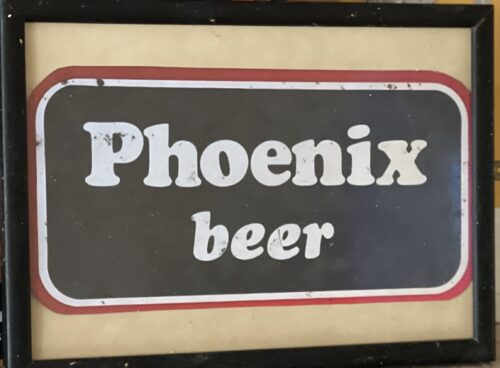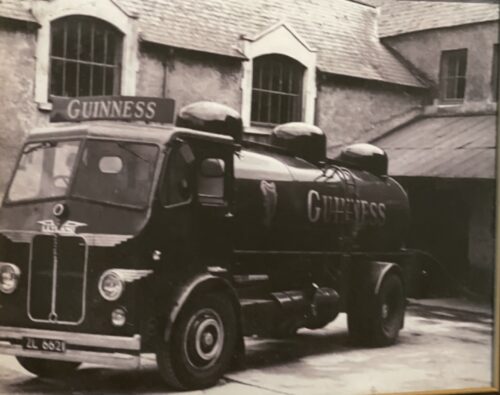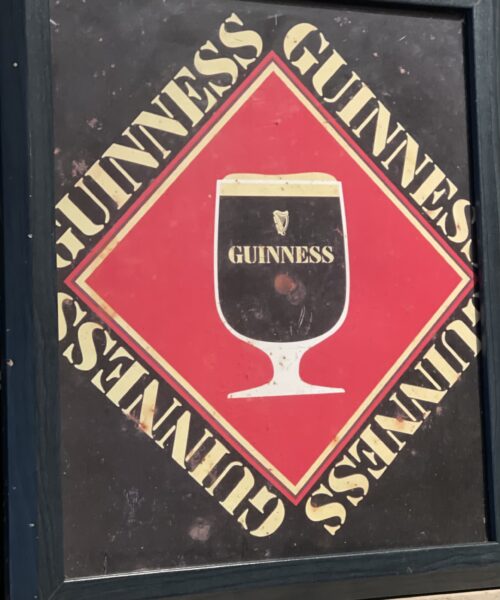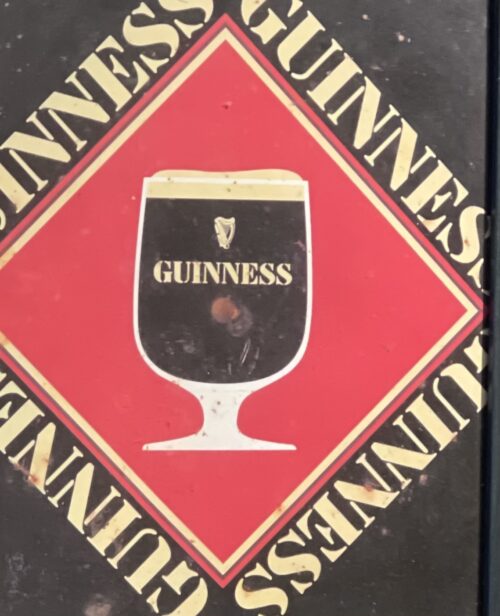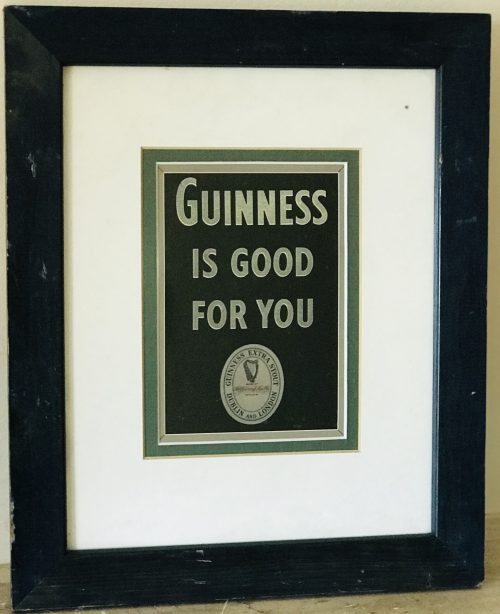55cm x 45cm
Luke Kelly (17 November 1940 – 30 January 1984) was an Irish singer,
folk musician and actor from
Dublin, Ireland. Born into a working-class household in Dublin city, Kelly moved to England in his late teens and by his early 20s had become involved in a folk music revival. Returning to Dublin in the 1960s, he is noted as a founding member of the band
The Dubliners in 1962. Becoming known for his distinctive singing style, and sometimes political messages, the
Irish Postand other commentators have regarded Kelly as one of Ireland's greatest folk singers.
Early life
Luke Kelly was born into a working-class family in Lattimore Cottages at 1
Sheriff Street.
His maternal grandmother, who was a MacDonald from
Scotland, lived with the family until her death in 1953. His father who was Irish- also named Luke
- was shot and severely wounded as a child by British soldiers from the
King's Own Scottish Borderers during the 1914
Bachelor's Walk massacre.
His father worked all his life in
Jacob's biscuit factory and enjoyed playing football. The elder Luke was a keen singer: Luke junior's brother Paddy later recalled that "he had this talent... to sing
negro spirituals by people like
Paul Robeson, we used to sit around and join in — that was our entertainment". After
Dublin Corporation demolished Lattimore Cottages in 1942, the Kellys became the first family to move into the St. Laurence O’Toole flats, where Luke spent the bulk of his childhood, although the family were forced to move by a fire in 1953 and settled in the
Whitehall area.
Both Luke and Paddy played club
Gaelic football and
soccer as children.
Kelly left school at thirteen and after a number of years of odd-jobbing, he went to England in 1958.
[6] Working at steel fixing with his brother Paddy on a building site in
Wolverhampton, he was apparently sacked after asking for higher pay.
He worked a number of odd jobs, including a period as a vacuum cleaner salesman.
Describing himself as a
beatnik, he travelled
Northern England in search of work, summarising his life in this period as "cleaning lavatories, cleaning windows, cleaning railways, but very rarely cleaning my face".
Musical beginnings
Kelly had been interested in music during his teenage years: he regularly attended
céilithe with his sister Mona and listened to American vocalists including:
Fats Domino,
Al Jolson,
Frank Sinatra and
Perry Como. He also had an interest in theatre and musicals, being involved with the staging of plays by Dublin's Marian Arts Society.
The first folk club he came across was in the Bridge Hotel,
Newcastle upon Tyne in early 1960.
Having already acquired the use of a
banjo, he started memorising songs. In
Leeds he brought his banjo to sessions in McReady's pub. The folk revival was under way in England: at the centre of it was
Ewan MacColl who scripted a radio programme called
Ballads and Blues. A revival in the
skiffle genre also injected a certain energy into folk singing at the time.
Kelly started
busking. On a trip home he went to a
fleadh cheoil in
Milltown Malbay on the advice of
Johnny Moynihan. He listened to recordings of
Woody Guthrie and
Pete Seeger. He also developed his political convictions which, as
Ronnie Drew pointed out after his death, he stuck to throughout his life. As Drew also pointed out, he "learned to sing with perfect diction".
Kelly befriended Sean Mulready in
Birmingham and lived in his home for a period.
Mulready was a teacher who was forced from his job in Dublin because of his communist beliefs.
Mulready had strong music links; a sister, Kathleen Moynihan was a founder member of
Comhaltas Ceoltóirí Éireann, and he was related by marriage to Festy Conlon, the
County Galway whistle player. Mulready's brother-in-law, Ned Stapleton, taught Kelly "The
Rocky Road to Dublin".
During this period he studied literature and politics under the tutelage of Mulready, his wife Mollie, and Marxist classicist
George Derwent Thomson: Kelly later stated that his interest in music grew parallel to his interest in politics.
Kelly bought his first banjo, which had five strings and a long neck, and played it in the style of
Pete Seeger and
Tommy Makem. At the same time, Kelly began a habit of reading, and also began playing golf on one of Birmingham's municipal courses.
He got involved in the Jug O'Punch folk club run by
Ian Campbell. He befriended
Dominic Behan and they performed in folk clubs and Irish pubs from London to
Glasgow. In London pubs, like "The Favourite", he would hear street singer Margaret Barry and musicians in exile like Roger Sherlock,
Seamus Ennis, Bobby Casey and Mairtín Byrnes.
Luke Kelly was by now active in the
Connolly Association, a left-wing grouping strongest among the emigres in England, and he also joined the
Young Communist League: he toured Irish pubs playing his set and selling the Connolly Association's newspaper
The Irish Democrat. By 1962
George Derwent Thomson had offered him the opportunity to further his educational and political development by attending university in
Prague. However, Kelly turned down the offer in favour of pursuing his career in folk music.
He was also to start frequenting Ewan MacColl and
Peggy Seeger's Singer Club in London.
The Dubliners
In 1961 there was a
folk music revival or "ballad boom", as it was later termed, in waiting in Ireland.
The Abbey Tavern sessions in
Howth were the forerunner to sessions in the Hollybrook,
Clontarf, the International Bar and the
Grafton Cinema. Luke Kelly returned to Dublin in 1962.
O'Donoghue's Pub was already established as a session house and soon Kelly was singing with, among others,
Ronnie Drew and
Barney McKenna. Other early people playing at O'Donoghues included
The Fureys, father and sons, John Keenan and Sean Og McKenna, Johnny Moynihan, Andy Irvine, Seamus Ennis, Willy Clancy and Mairtin Byrnes.
A concert John Molloy organised in the Hibernian Hotel led to his "Ballad Tour of Ireland" with the Ronnie Drew Ballad Group (billed in one town as the Ronnie Drew
Ballet Group).
This tour led to the Abbey Tavern and the Royal Marine Hotel and then to jam-packed sessions in the Embankment,
Tallaght.
Ciarán Bourke joined the group, followed later by
John Sheahan. They renamed themselves
The Dubliners at Kelly's suggestion, as he was reading
James Joyce's book of short stories, entitled
Dubliners, at the time.
Kelly was the leading vocalist for the group's
eponymous debut album in 1964, which included his rendition of "The Rocky Road to Dublin". Barney McKenna later noted that Kelly was the only singer he'd heard sing it to the rhythm it was played on the fiddle.
In 1964 Luke Kelly left the group for nearly two years and was replaced by
Bobby Lynch and
John Sheahan.
Kelly went with
Deirdre O'Connell, founder of the
Focus Theatre, whom he was to marry the following year, back to London and became involved in
Ewan MacColl's "gathering". The Critics, as it was called, was formed to explore folk traditions and help young singers. During this period he retained his political commitments, becoming increasingly active in the
Campaign for Nuclear Disarmament. Kelly also met and befriended
Michael O'Riordan, the General Secretary of the
Irish Workers' Party, and the two developed a "personal-political friendship".
Kelly endorsed O'Riordan for election, and held a rally in his name during campaigning in 1965.
In 1965, he sang '
The Rocky Road to Dublin' with
Liam Clancy on his first, self-titled solo album.
Bobby Lynch left The Dubliners, John Sheahan and Kelly rejoined. They recorded an album in the Gate Theatre, Dublin, played the
Cambridge Folk Festival and recorded
Irish Night Out, a live album with, among others, exiles Margaret Barry, Michael Gorman and Jimmy Powers. They also played a concert in the
National Stadium in Dublin with Pete Seeger as special guest.
They were on the road to success: Top Twenty hits with "
Seven Drunken Nights" and "
The Black Velvet Band",
The Ed Sullivan Show in 1968 and a tour of
New Zealand and Australia. The ballad boom in Ireland was becoming increasingly commercialised with bar and pub owners building ever larger venues for pay-in performances. Ewan MacColl and Peggy Seeger on a visit to Dublin expressed concern to Kelly about his drinking.
[citation needed]
Christy Moore and Kelly became acquainted in the 1960s.
During his
Planxty days, Moore got to know Kelly well. In 1972 The Dubliners themselves performed in
Richard's Cork Leg, based on the "incomplete works" of
Brendan Behan. In 1973, Kelly took to the stage performing as
King Herod in
Jesus Christ Superstar.
The arrival of a new manager for The Dubliners,
Derry composer
Phil Coulter, resulted in a collaboration that produced three of Kelly's most notable performances: “
The Town I Loved So Well”, "Hand me Down my Bible", and “
Scorn Not His Simplicity”, a song about Phil's son who had
Down Syndrome.
Kelly had such respect for the latter song that he only performed it once for a television recording and rarely, if ever, sang it at the Dubliners' often boisterous events.
His interpretations of “
On Raglan Road” and "Scorn Not His Simplicity" became significant points of reference in Irish folk music.His version of "Raglan Road" came about when the poem's author,
Patrick Kavanagh, heard him singing in a Dublin pub, and approached Kelly to say that he should sing the poem (which is set to the tune of “
The Dawning of the Day”).
Kelly remained a politically engaged musician,
becoming a supporter of the
movement against South African apartheid and performing at benefit concerts for the
Irish Traveller community,
and many of the songs he recorded dealt with social issues, the
arms race and the
Cold War,
trade unionism and
Irish republicanism, ("The Springhill Disaster", "Joe Hill", "The Button Pusher", "Alabama 1958" and "
God Save Ireland" all being examples of his concerns).

Luke Kelly on stage in 1980
Personal life
Luke Kelly married
Deirdre O'Connell in 1965, but they separated in the early 1970s.
Kelly spent the last eight years of his life living with his partner Madeleine Seiler, who is from Germany.
Final years
Kelly's health deteriorated in the 1970s. Kelly himself spoke about his problems with alcohol.
On 30 June 1980 during a concert in the
Cork Opera House he collapsed on the stage.
He had already suffered for some time from migraines and forgetfulness - including forgetting what country he was in whilst visiting
Iceland - which had been ascribed to his intense schedule, alcohol consumption, and "party lifestyle".
A
brain tumour was diagnosed.
Although Kelly toured with the Dubliners after enduring an operation, his health deteriorated further. He forgot lyrics and had to take longer breaks in concerts as he felt weak. In addition following his emergency surgery after his collapse in Cork, he became more withdrawn, preferring the company of Madeleine at home to performing.
On his European tour he managed to perform with the band for most of the show in Carre for their
Live in Carre album. However, in autumn 1983 he had to leave the stage in
Traun,
Austria and again in
Mannheim, Germany. Shortly after this, he had to cancel the tour of southern Germany, and after a short stay in hospital in
Heidelberg he was flown back to Dublin.
After another operation he spent Christmas with his family but was taken into hospital again in the New Year, where he died on 30 January 1984.
Kelly's funeral in
Whitehall attracted thousands of mourners from across Ireland.
His gravestone in
Glasnevin Cemetery, Dublin, bears the inscription:
Luke Kelly – Dubliner.
Sean Cannon took Kelly's place in The Dubliners. He had been performing with the Dubliners since 1982,
due to the deterioration of Kelly's health.
Legacy

Statue on South King Street
Luke Kelly's legacy and contributions to Irish music and culture have been described as "iconic" and have been captured in a number of documentaries and anthologies.
The influence of his Scottish grandmother was influential in Kelly's help in preserving important traditional Scottish songs such as "Mormond Braes", the Canadian folk song "
Peggy Gordon", "Robert Burns", "
Parcel of Rogues", "Tibbie Dunbar",
Hamish Henderson's "
Freedom Come-All-Ye", and Thurso Berwick's "Scottish Breakaway".
The
Ballybough Bridge in the north inner city of Dublin was renamed the Luke Kelly Bridge,
and in November 2004 Dublin City Council voted unanimously to erect a
bronze statue of Luke Kelly.
However, the Dublin Docklands Authority subsequently stated that it could no longer afford to fund the statue. In 2010, councillor Christy Burke of Dublin City Council appealed to members of the music community including
Bono,
Phil Coulter and
Enya to help build it.
Paddy Reilly recorded a tribute to Kelly
entitled "The Dublin Minstrel". It featured on his
Gold And Silver Years,
Celtic Collections and the
Essential Paddy Reilly CD's. The Dubliners recorded the song on their
Live at Vicar Street DVD/CD. The song was composed by Declan O'Donoghue, the Racing Correspondent of
The Irish Sun.
At Christmas 2005 writer-director
Michael Feeney Callan's documentary,
Luke Kelly: The Performer, was released and outsold
U2's latest DVD during the festive season and into 2006, acquiring platinum sales status. The documentary told Kelly's story through the words of the Dubliners,
Donovan,
Ralph McTell and others and featured full versions of rarely seen performances such as the early sixties'
Ed Sullivan Show. A later documentary,
Luke Kelly: Prince of the City, was also well received.
Two statues of Kelly were unveiled in Dublin in January 2019, to mark the 35th anniversary of his death.
One, a life-size seated bronze by John Coll, is on South King Street. The second sculpture,
a marble portrait head by
Vera Klute, is on
Sheriff Street. The Klute sculpture was vandalised on several occasions in 2019 and 2020, in each case being restored by graffiti-removal specialists.
 The 1938 All-Ireland Football Final Replay on October 23rd, 1938 ended in the most bizarre fashion imaginable when with 2 minutes left to play, Galway supporters, mistakenly believing the referee had blown for full-time, invaded the pitch, causing a 20 minute delay before the final minutes could be played out.
Even more dramatic was the fact that by the time the pitch was cleared, most of the Kerry players seemed to have disappeared.
The 1938 All-Ireland Football Final Replay on October 23rd, 1938 ended in the most bizarre fashion imaginable when with 2 minutes left to play, Galway supporters, mistakenly believing the referee had blown for full-time, invaded the pitch, causing a 20 minute delay before the final minutes could be played out.
Even more dramatic was the fact that by the time the pitch was cleared, most of the Kerry players seemed to have disappeared.
 The confusion all began with a free awarded to Kerry by referee Peter Waters of Kildare with Galway leading the defending champions, by 2-4 to 0-6.
The referee placed the ball and blew his whistle for the kick to be taken while running towards the Galway goals. He looked round just as Sean Brosnan was taking the kick and seeing a Galway player too close he blew for the kick to be retaken.
Thinking that he had blown for full-time the jubilant Galway supporters invaded the pitch.
The confusion all began with a free awarded to Kerry by referee Peter Waters of Kildare with Galway leading the defending champions, by 2-4 to 0-6.
The referee placed the ball and blew his whistle for the kick to be taken while running towards the Galway goals. He looked round just as Sean Brosnan was taking the kick and seeing a Galway player too close he blew for the kick to be retaken.
Thinking that he had blown for full-time the jubilant Galway supporters invaded the pitch.
 It took all of twenty minutes to clear the pitch but only then did the real problems come to light. Jerry O’Leary Chairman of the Kerry Selection Committee outlined their dilemma.
It took all of twenty minutes to clear the pitch but only then did the real problems come to light. Jerry O’Leary Chairman of the Kerry Selection Committee outlined their dilemma.

 Somehow or other Kerry managed to re-field even if the team which played out the remaining minutes bore little resemblance to the starting fifteen.
Somehow or other Kerry managed to re-field even if the team which played out the remaining minutes bore little resemblance to the starting fifteen.
 More remarkable again was the fact that Kerry went on to add another point to their total before the referee finally blew for full-time with Galway winners by 2-4 to 0-7.
It was generally agreed that the confusion was of the crowd’s and not the referee’s making but questions remained about the total number of players Kerry had been permitted to use in those final few minutes.
More remarkable again was the fact that Kerry went on to add another point to their total before the referee finally blew for full-time with Galway winners by 2-4 to 0-7.
It was generally agreed that the confusion was of the crowd’s and not the referee’s making but questions remained about the total number of players Kerry had been permitted to use in those final few minutes.
 The National and Provincial papers and indeed all available Records to this day list only those 16 Kerry players who were involved prior to the 20 minute interruption but now (80 years on) for the first time all the players who played for Kerry in that October 23rd, 1938 All-Ireland Final Replay can be given their rightful place in the Record Books.
KERRY’s 24:
The National and Provincial papers and indeed all available Records to this day list only those 16 Kerry players who were involved prior to the 20 minute interruption but now (80 years on) for the first time all the players who played for Kerry in that October 23rd, 1938 All-Ireland Final Replay can be given their rightful place in the Record Books.
KERRY’s 24:

 That night, in front of a 1,500 crowd, at a Gaelic League organised Siamsa Mór in the Mansion House in Dawson Street, Art McCann presented the Galway team with their winners’ medals.
That night, in front of a 1,500 crowd, at a Gaelic League organised Siamsa Mór in the Mansion House in Dawson Street, Art McCann presented the Galway team with their winners’ medals.
 The Kerry players meanwhile joined 300 of their suppoeters at a Ceilidhe hosted by the Kerrymen’s Social Club in Rathmines Town Hall.
The National Newspapers may not always have reported the facts to Galway’s satisfaction but there can be no questioning the support of Galway County Council.
The Kerry players meanwhile joined 300 of their suppoeters at a Ceilidhe hosted by the Kerrymen’s Social Club in Rathmines Town Hall.
The National Newspapers may not always have reported the facts to Galway’s satisfaction but there can be no questioning the support of Galway County Council.
 Needless to say the Galway players received an unprecedented welcome on their return to Galway having first been feted along the way in Mullingar, Streamstown, Moate and Athlone.
GALWAY – 1938 ALL-IRELAND SENIOR FOOTBALL CHAMPIONS
Needless to say the Galway players received an unprecedented welcome on their return to Galway having first been feted along the way in Mullingar, Streamstown, Moate and Athlone.
GALWAY – 1938 ALL-IRELAND SENIOR FOOTBALL CHAMPIONS
 Back (L-R) Bobby Beggs, Ralph Griffin, John Burke, Jimmy McGauran, Charlie Connolly, Brendan Nestor, Dinny Sullivan, Mick Connaire, Martin Kelly. Front (L-R) Frank Cunniffe, Jackie Flavin, Mick Higgins, John ‘Tull’ Dunne (Capt), Ned Mulholland, Mick Raftery.
Substitutes: (not in photograph) Mick Ryder and Pat McDonagh.
TIME ADDED ON:
Not far behind the controversy surrounding the last few minutes of 1938 All-Ireland Football Final Replay was the controversy surrounding the last few seconds of the drawn match played a month earlier.
Back (L-R) Bobby Beggs, Ralph Griffin, John Burke, Jimmy McGauran, Charlie Connolly, Brendan Nestor, Dinny Sullivan, Mick Connaire, Martin Kelly. Front (L-R) Frank Cunniffe, Jackie Flavin, Mick Higgins, John ‘Tull’ Dunne (Capt), Ned Mulholland, Mick Raftery.
Substitutes: (not in photograph) Mick Ryder and Pat McDonagh.
TIME ADDED ON:
Not far behind the controversy surrounding the last few minutes of 1938 All-Ireland Football Final Replay was the controversy surrounding the last few seconds of the drawn match played a month earlier.

 The sides were level, Kerry 2-06 Galway 3-03, when Kerry’s J.J. Landers sent the ball between the Galway uprights for what looked like the winning point. However the thousands of celebrating Kerry supporters making for the Croke Park exits were soon stopped in their tracks.
The sides were level, Kerry 2-06 Galway 3-03, when Kerry’s J.J. Landers sent the ball between the Galway uprights for what looked like the winning point. However the thousands of celebrating Kerry supporters making for the Croke Park exits were soon stopped in their tracks.
 It was cruel luck on Kerry and while there were many who criticised the referee, Tom Culhane from Glin, County Limerick, for blowing the final whistle while John Joe Landers was it the act of shooting, Kerry’s County Board Chairman Denis J. Bailey wasn’t among them.
At the next Central Council meeting, in a remarkably generous response to the Referee’s Report being read he stated that ‘they in Kerry were quite satisfied with the result’ and ‘They wished to pay a tribute to Galway for their sporting spirit and also to the referee who, in their opinion, carried out his duties very well.’
The Central Council then awarded the two counties £300 each towards the costs of the two-week Collective Training Camps both counties had planned in the lead up to the Replay on October 23rd. Munster Council granted Kerry (pictured here in Collective Training) an additional £100.
It was cruel luck on Kerry and while there were many who criticised the referee, Tom Culhane from Glin, County Limerick, for blowing the final whistle while John Joe Landers was it the act of shooting, Kerry’s County Board Chairman Denis J. Bailey wasn’t among them.
At the next Central Council meeting, in a remarkably generous response to the Referee’s Report being read he stated that ‘they in Kerry were quite satisfied with the result’ and ‘They wished to pay a tribute to Galway for their sporting spirit and also to the referee who, in their opinion, carried out his duties very well.’
The Central Council then awarded the two counties £300 each towards the costs of the two-week Collective Training Camps both counties had planned in the lead up to the Replay on October 23rd. Munster Council granted Kerry (pictured here in Collective Training) an additional £100.
 Prior to that Central Council meeting, General Secretary, Pádraig Ó’Caoimh, received a telephone call from the New York GAA suggesting the replay take place in New York but the request (which was successfully repeated nine years later in 1947) was on this occasion turned down.
However doubts about the Replay even going ahead were immediately raised.
Prior to that Central Council meeting, General Secretary, Pádraig Ó’Caoimh, received a telephone call from the New York GAA suggesting the replay take place in New York but the request (which was successfully repeated nine years later in 1947) was on this occasion turned down.
However doubts about the Replay even going ahead were immediately raised.
 Satisfactory transport arrangements were eventually agreed and the match went ahead although the Kerry supporters who left Tralee on the so-called ‘ghost’ train at 1am on the morning of the October 23rd may still have felt hard done by.
Satisfactory transport arrangements were eventually agreed and the match went ahead although the Kerry supporters who left Tralee on the so-called ‘ghost’ train at 1am on the morning of the October 23rd may still have felt hard done by.
 In the lead-up to the game the Galway selectors expressed their delight at the success of their forwards short hand-passing game against the Kerry backs in the drawn match although there were some worries that not all their players had been able to attend the first week of Collective Training and of course there was Kerry’s Replay record to be considered.
Kerry had previously played in 4 All-Ireland Replays and won them all, a great source of encouragement to the Kerry supporters.
However amid some reports of disharmony within the Kerry camp, following a ‘trial match’ on the Sunday before the Replay, the Kerry selection Committee dropped a real bombshell.
Joe Keohane (Dublin Geraldines) who had been Kerry’s regular full-back for the previous two years and was one of the stars of their 1937 All-Ireland win over Cavan was replaced by young Paddy ‘Bawn’ Brosnan a member of the 1938 Kerry Junior team.
A back injury to Kerry’s best forward, J.J. Landers made him an extreme doubt for the Replay with Martin Regan on stand-by to take his place if required which is exactly what happened before that fateful free-kick, that infamous 20 minute delay and Kerry’s unprecedented use of 24 players.
Most definitely an All-Ireland Final and Final Replay never to be forgotten.
In the lead-up to the game the Galway selectors expressed their delight at the success of their forwards short hand-passing game against the Kerry backs in the drawn match although there were some worries that not all their players had been able to attend the first week of Collective Training and of course there was Kerry’s Replay record to be considered.
Kerry had previously played in 4 All-Ireland Replays and won them all, a great source of encouragement to the Kerry supporters.
However amid some reports of disharmony within the Kerry camp, following a ‘trial match’ on the Sunday before the Replay, the Kerry selection Committee dropped a real bombshell.
Joe Keohane (Dublin Geraldines) who had been Kerry’s regular full-back for the previous two years and was one of the stars of their 1937 All-Ireland win over Cavan was replaced by young Paddy ‘Bawn’ Brosnan a member of the 1938 Kerry Junior team.
A back injury to Kerry’s best forward, J.J. Landers made him an extreme doubt for the Replay with Martin Regan on stand-by to take his place if required which is exactly what happened before that fateful free-kick, that infamous 20 minute delay and Kerry’s unprecedented use of 24 players.
Most definitely an All-Ireland Final and Final Replay never to be forgotten.
 The Galway and Kerry players parade in front of the newly opened (1938) Cusack Stand
The Galway and Kerry players parade in front of the newly opened (1938) Cusack Stand













